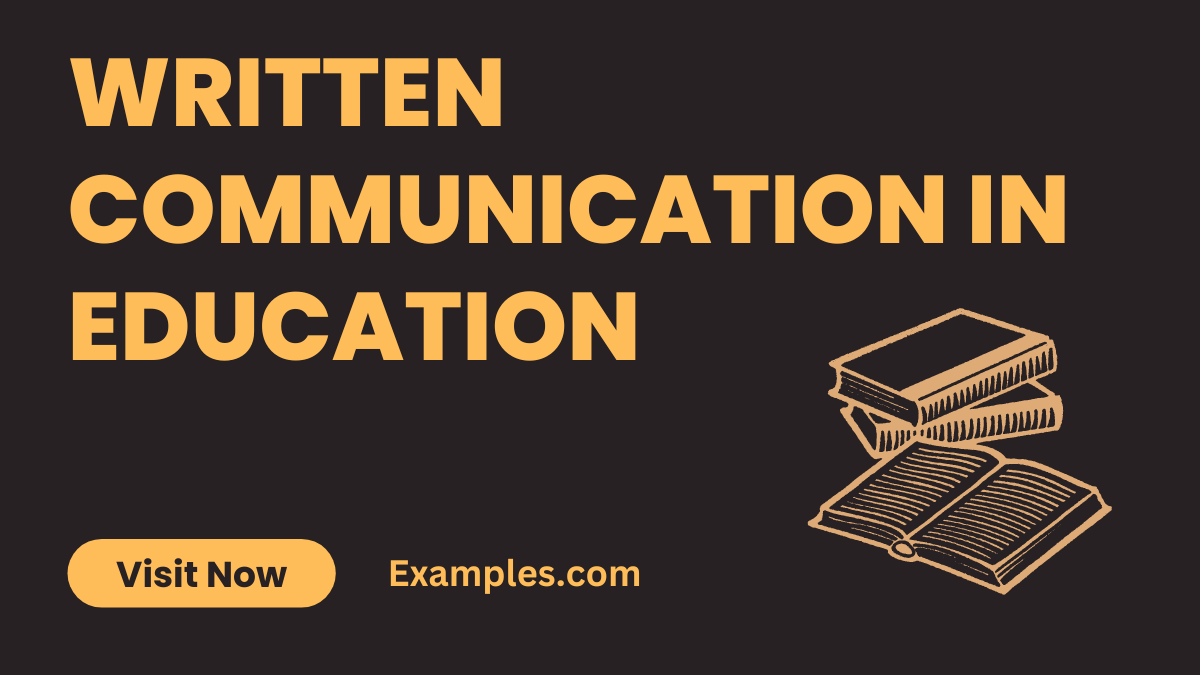9+ Written Communication in Education Examples
Written communication in education is an essential tool for imparting and acquiring knowledge. This guide delves deep into various communication examples, demonstrating how written words can significantly influence educational outcomes. Understanding the Importance of Written Communication and its practical application through Written Communication Sentence Examples enriches both teaching and learning experiences. Whether it’s in Written Communication in Schools or Written Communication in the Classroom, this guide offers invaluable insights into developing and honing written communication skills, making it an indispensable resource for educators and learners.
What is Written Communication in Education?

Written communication in education refers to the exchange of ideas and information through written text. It plays a crucial role in Written Communication in Education, encompassing a range of formats from essays to digital communications. Effective written communication is key to conveying knowledge and assessing student understanding. It involves clarity, coherence, and audience awareness, crucial in Written Communication in Schools and Written Communication in the Classroom, highlighting the ongoing need to improve these skills for educational success.
Examples of Written Communication in Education

- Email Communication to Students: Often lacks personalization.
How to Fix: Use Written Communication Sentence Examples to create more engaging and personalized emails. - Assignment Instructions: Sometimes vague or confusing.
How to Fix: Clarify instructions, possibly reviewed in a Written Communication Journal for consistency. - Digital Class Announcements: Can be overlooked if not engaging.
How to Fix: Employ attention-grabbing formats and clear language, highlighting the Characteristics of Written Communication. - Essay Feedback: May be too general.
How to Fix: Provide specific, constructive feedback, utilizing Written Communication Skills for clarity. - Research Paper Guidelines: Can be complex and intimidating.
How to Fix: Break down instructions into simpler steps, emphasizing the Importance of Written Communication in research. - Online Discussion Posts: Sometimes lack depth.
How to Fix: Encourage detailed responses by setting clear expectations and examples. - Classroom Handouts: Risk being monotonous.
How to Fix: Make handouts visually appealing and succinct, demonstrating effective Written Communication in Education. - Group Project Plans: Often suffer from miscommunication.
How to Fix: Use clear, structured communication strategies. - Student Journals: May lack reflective depth.
How to Fix: Provide guiding questions and prompts, illustrating How to Improve Written Communication. - Educational Blogs: Can be inconsistent in tone.
How to Fix: Establish a consistent voice and style guide, reflecting on Written Communication in Business practices for professionalism.
How Does Written Communication Help Students?
- Enhances Critical Thinking: Writing helps in organizing thoughts, leading to better critical analysis.
- Clarity in Expression: Regular writing practices improve clarity and precision in conveying ideas.
- Creative Articulation: Encourages creative expression of thoughts and concepts.
- Skill Development: Builds essential Written Communication Skills needed for academic and professional success.
- Feedback and Refinement: Through Teacher Feedback on Assignments, students learn to refine and improve their communication.
Why is Written Communication Important in Academics?
- Structures Thoughts: Writing is key for organizing and presenting complex ideas.
- Note-Taking and Organization: Effective Note-Taking Strategies help in assimilating and retaining information.
- Evaluates Understanding: Plays a critical role in Educational Writing Assessments.
- Academic Research: Essential for presenting research and collaboration.
- Long-Term Skill: Supports academic and career advancements, emphasizing the Importance of Written Communication.
What are the Major Advantages of Written Communication?
The major advantages of written communication, especially in educational settings, include:
- Permanent Record: It creates a permanent record of information, aiding in future references.
- Clear Communication: Offers clarity and precision, which are crucial aspects of Written Communication in Schools and Written Communication in Education.
- Develops Critical Skills: Enhances Written Communication Skills that are vital for academic and career success.
- Promotes Organized Thought: Encourages students to structure their thoughts coherently.
- Feedback and Improvement: Facilitates Teacher Feedback on Assignments, allowing for continuous improvement.
What are the Benefits of Communication in Education?
The benefits of communication in education are numerous:
- Enhances Learning: Effective communication boosts understanding and retention of information.
- Facilitates Collaboration: Encourages teamwork, critical in Written Communication in the Classroom.
- Improves Engagement: Keeps students engaged and motivated in their learning process.
- Skill Development: Nurtures essential communication skills, a key part of the Importance of Written Communication.
- Broad Application: Skills gained are applicable in various fields, reflecting Written Communication in Business and Written Communication in Nursing.
What is the Most Common Form of Written Communication?
The most common form of written communication, especially in educational settings, is email. It’s widely used for its efficiency and convenience in Written Communication in Education and Written Communication in Schools.
Is Written Communication Verbal or Nonverbal?
Written communication is a form of nonverbal communication. It relies on written text to convey messages, distinct from verbal communication’s spoken words, and is integral in Written Communication in the Classroom.
What is Effective Classroom Communication?
Effective classroom communication involves clear, concise, and engaging exchanges between teachers and students. It’s fundamental for learning and is a key aspect of Written Communication Skills in educational settings.
“Written Communication in Education,” it’s beneficial to emphasize the broad impact of these skills across various academic and professional realms. The article could highlight how effective written communication not only aids in educational success but also lays a foundation for future careers, including areas like Written Communication in Business. For additional insights on enhancing communication skills, a link to Bronx Community College’s General Education Assessment on Written Communication would be valuable.
Additionally, discussing the evolving role of technology in written communication in educational settings is crucial. Recommending resources like Waterford.org, which offers further insights into communication skills, can provide readers with modern tools and techniques for improving Written Communication in Education.



